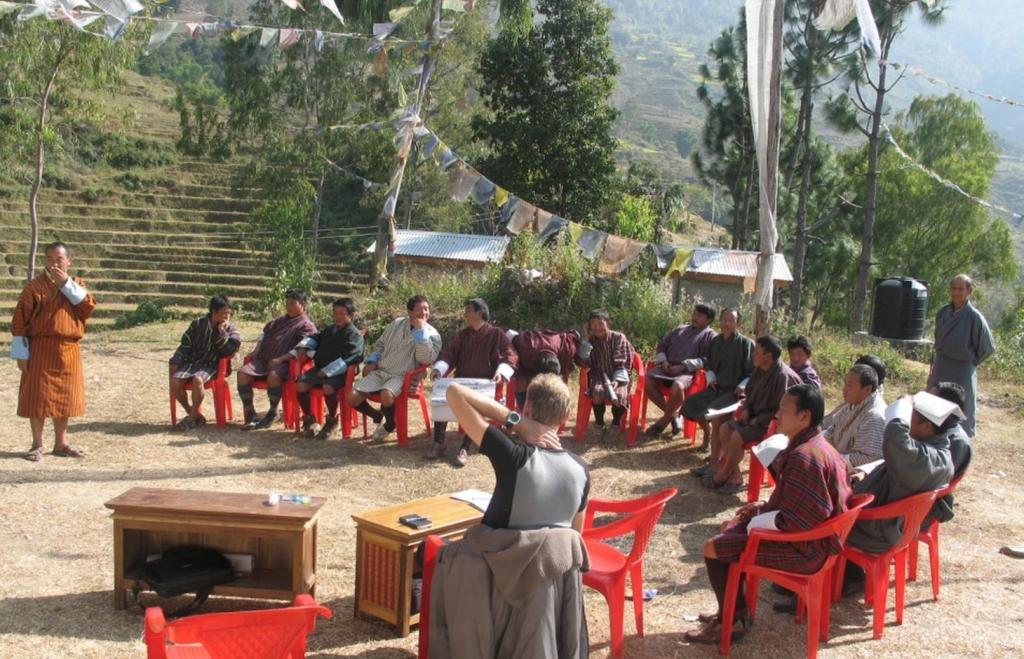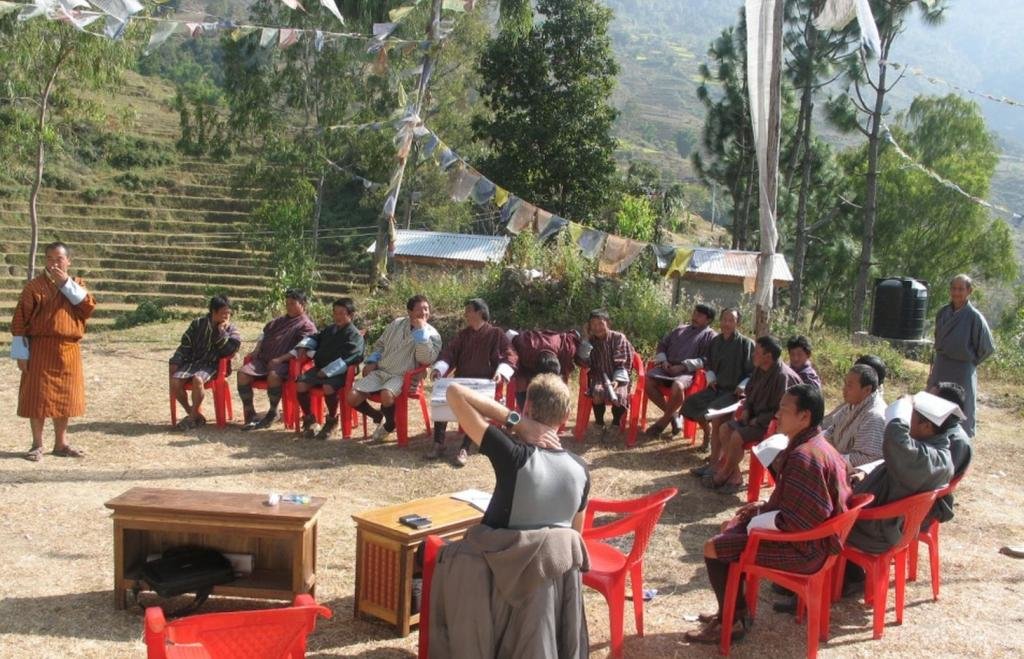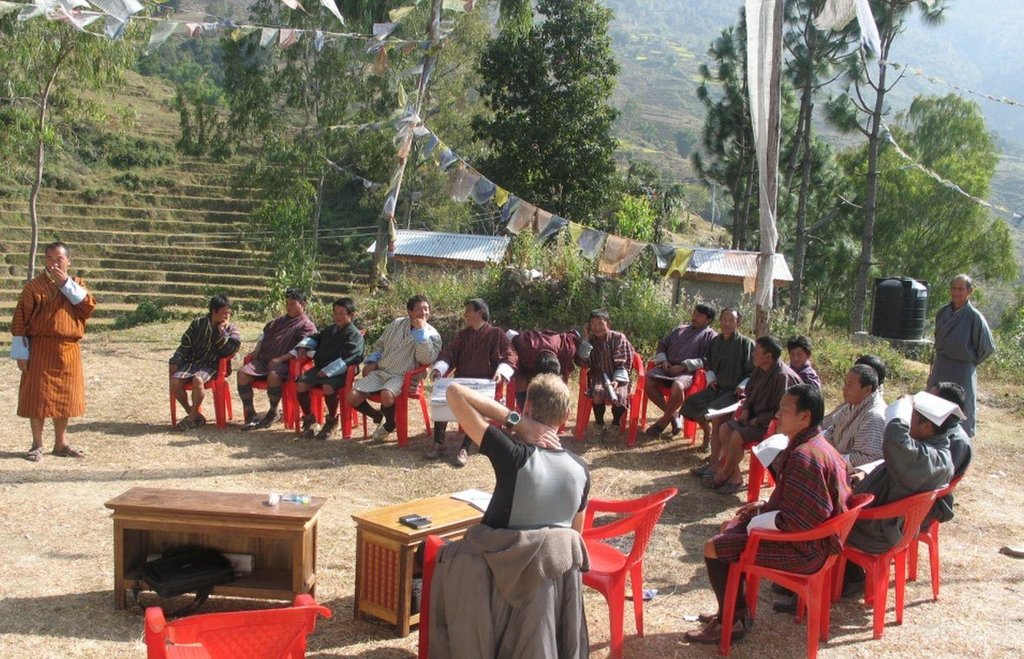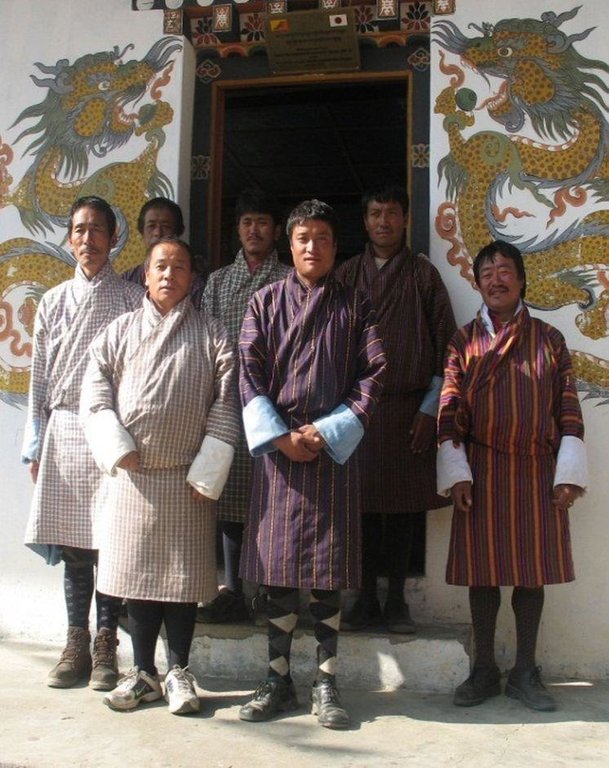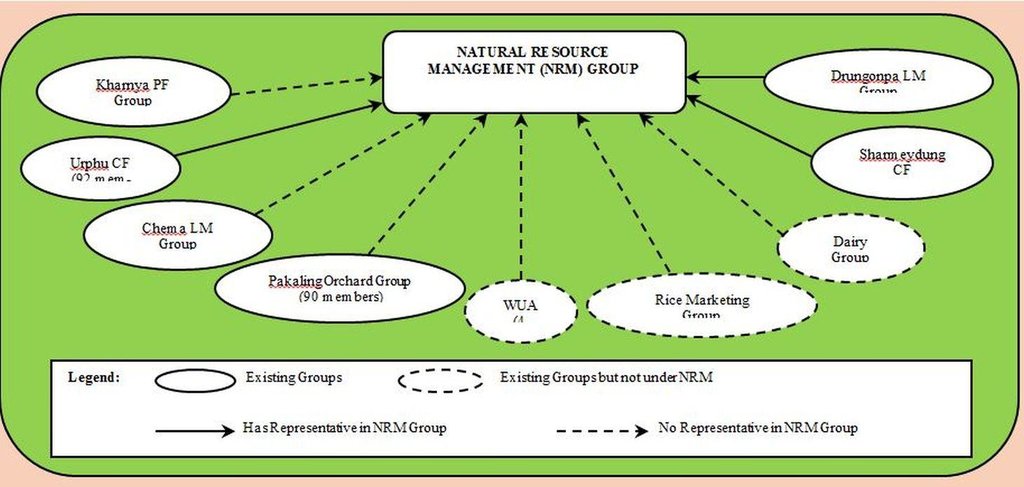Natural Resource Mangement Group [ប្រទេសប៊ូតង់]
- ការបង្កើត៖
- បច្ចុប្បន្នភាព
- អ្នកចងក្រង៖ Karma Dorji
- អ្នកកែសម្រួល៖ –
- អ្នកត្រួតពិនិត្យ Fabian Ottiger
Rangzhing Nitang Sunchop Tshogpa (Dzongkha)
approaches_2492 - ប្រទេសប៊ូតង់
ពិនិត្យមើលគ្រប់ផ្នែក
ពង្រីកមើលទាំងអស់ បង្រួមទាំងអស់1. ព័ត៌មានទូទៅ
1.2 ព័ត៌មានលម្អិតពីបុគ្គលសំខាន់ៗ និងស្ថាប័នដែលចូលរួមក្នុងការវាយតម្លៃ និងចងក្រងឯកសារនៃវិធីសាស្ត្រផ្សព្វផ្សាយ
ឈ្មោះអង្គភាពមួយ (ច្រើន) ដែលបានចងក្រងឯកសារ/ វាយតម្លៃលើវិធីសាស្ត្រផ្សព្វផ្សាយ (បើទាក់ទង)
MoA (MoA) - ប្រទេសប៊ូតង់ឈ្មោះអង្គភាពមួយ (ច្រើន) ដែលបានចងក្រងឯកសារ/ វាយតម្លៃលើវិធីសាស្ត្រផ្សព្វផ្សាយ (បើទាក់ទង)
National Soil Services Centre (National Soil Services Centre) - ប្រទេសប៊ូតង់1.3 លក្ខខណ្ឌទាក់ទងទៅនឹងការប្រើប្រាស់ទិន្នន័យដែលបានចងក្រងតាមរយៈវ៉ូខេត
តើពេលណាដែលទិន្នន័យបានចងក្រង (នៅទីវាល)?
23/03/2011
អ្នកចងក្រង និង(បុគ្គលសំខាន់ៗ)យល់ព្រមទទួលយកនូវលក្ខខណ្ឌនានាទាក់ទងទៅនឹងការប្រើប្រាស់ទិន្នន័យដែលបានចងក្រងតាមរយៈ វ៉ូខេត:
បាទ/ចា៎
2. ការពណ៌នាអំពីវិធីសាស្ត្រផ្សព្វផ្សាយ SLM
2.1 ពណ៌នាសង្ខេបខ្លីពីវិធីសាស្ត្រផ្សព្វផ្សាយ
Natural Resource Management Group consisting of village representatives to advocate, plan and implement SLM activities at geog level
2.2 ពណ៌នាលម្អិតពិវិធីសាស្ត្រផ្សព្វផ្សាយ
ពណ៌នាលម្អិតពិវិធីសាស្ត្រផ្សព្វផ្សាយ:
Aims / objectives: The Natural Resource Management (NRM) Group was formally established in Radhi geog in 2000 with representatives from all 20 chiogs of the geog. The main tasks of the group are to :1)mobilise local communities in rehabilitating and protecting natural resources from further degradation and 2) to support geog administration, RNR staff and other agencies in planning, implementing and monitoring sustainable natural resource management activities. Radhi geog in Trashigang Dzongkhag, East-Bhutan, has been confronted with severe land degradation as a result of unsustainable land management practices, such as deforestation, overgrazing and poor irrigation water management. The land degradation processes are related to high population pressure and a series of conflicts between chiogs and with neighbouring geogs about use and access to natural resources. Various stakeholders, engaged with reduction and mitigation of land degradation in Radhi, felt the need for a local institution, which should play a pivotal role in advocacy of sustainable management of natural resources. The group was also intended to assist in implementing remedial and preventive measures at village level.
Methods: The NRM group fulfilled a key role in the afforestation program for the Radhi wa-tershed, in particular the very active Chongdiri ravine, which has caused wide-spread loss of arable land and forced resettlement of households, because of a very active landslide area. The chiog representatives, united in the NRM group, mobilized villagers to actively participate in the afforestation and fencing of the buffer zone. This zone was created to arrest the critical land degradation and change unsustainable land management practices, such as free grazing cattle and irrigated paddy cultivation in an active mass movement area.
Seed money was provided to establish a group fund to provide small-scale loans to households for agricultural inputs in order to overcome existing credit access constraints. The intention was to enhance the viability and sustainability of the NRM Group.
Stages of implementation: Over the last 5 years approximately 250 loans have been disbursed of about US$60 each. The NRM group has a loose umbrella function at geog level over a number of sub-groups at chiog level, related to private forestry, community forestry, bamboo and rice marketing, water user associations and land man-agement. The present group structure needs to be reviewed to adapt to the large number of emerging sub-groups.
2.3 រូបភាពនៃវិធីសាស្ត្រផ្សព្វផ្សាយ
2.5 ប្រទេស/តំបន់/ទីតាំងកន្លែង ដែលវិធីសាស្ត្រផ្សព្វផ្សាយត្រូវបានអនុវត្តន៍
ប្រទេស:
ប្រទេសប៊ូតង់
បញ្ជាក់បន្ថែមពីលក្ខណៈនៃទីតាំង:
Trashigang Dzongkhag, Radhi geog
2.6 កាលបរិច្ឆេទនៃការចាប់ផ្តើម និងបញ្ចប់នៃវិធីសាស្រ្តផ្សព្វផ្សាយនេះ
សូមបញ្ជាក់ឆ្នាំដែលបានបង្កើតឡើង:
2000
ឆ្នាំបញ្ចប់ (ប្រសិនបើវិធីសាស្ត្រផ្សព្វផ្សាយត្រូវបានឈប់ប្រើប្រាស់):
2012
2.7 ប្រភេទនៃវិធីសាស្ត្រផ្សព្វផ្សាយ
- ផ្អែកលើគម្រោង/កម្មវិធី
2.8 គោលបំណង/ទិសដៅសំខាន់នៃវិធីសាស្ត្រផ្សព្វផ្សាយ
The Approach focused mainly on SLM with other activities (cash-income generation, NRM fund for SLM loans/credit facility)
- The main tasks of the group are to: 1) mobilise local communities in rehabilitating and protecting natural resources from further degradation and 2) to support municipality administration, RNR staff and other agencies in planning, implementing and monitoring sustainable natural resource management activities. A series of government programmes and projects initi-ated activities in Radhi geog and it was decided to create a local institution focused at building capacity in NR management, awareness raising and sensitization.
The SLM Approach addressed the following problems: - Widespread severe land degradation in densely populated area, related to forest degradation, overgrazing, poor irrigation water management, unfavourable geological conditions and NR management conflicts between chiogs and between geogs
2.9 លក្ខខណ្ឌអនុញ្ញាត ឬរារាំងការអនុវត្តន៍បច្ចេកទេសដែលស្ថិតនៅក្រោមវិធីសាស្រ្តផ្សព្វផ្សាយ
សង្គម/វប្បធម៌/ និងតម្លៃនៃសាសនា
- រារាំង
Conflicts between geogs (Radhi and Merak) over grazing rights and access, combined with conflicts between chiogs within Radhi over land and water use rights, all contributing to serious land degradation issues in Radhigeog
Treatment through the SLM Approach: Group meetings with chiog representatives; conflict mitigation workshops; formal conflict mitigation and eventually even formal judicial court cases; group formation and support to mitigate land degradation issues and come to consensus
ភាពអាចរកបាននៃធនធានហិរញ្ញវត្ថុ និងសេវាកម្ម
- រារាំង
Limited access to agricultural credit facilities
Treatment through the SLM Approach: Establishment of a local NRM group fund
ក្របខណ្ឌច្បាប់ (សិទ្ធិកាន់កាប់ដីធ្លី កម្មសិទ្ធីប្រើប្រាស់ដីនិងទឹក)
- អំណោយផល
The existing land ownership, land use rights / water rights moderately helped the approach implementation: Widespread land tenure facilitates participation level of land users in NRM/SLM activities. Government owned forests have partly been converted to Community Forests, now owned and managed by the local communities. Traditional grazing rights however, have created serious long-lasting inter-geog conflicts that have proved to be difficult to resolve, despite many mediation and judicial efforts.
3. ការចូលរួម និងតួនាទីរបស់ភាគីពាក់ព័ន្ធ
3.1 អ្នកពាក់ព័ន្ធដែលបានចូលរួមក្នុងវិធីសាស្ត្រផ្សព្វផ្សាយ និងតួនាទីរបស់ពួកគេ
- អ្នកប្រើប្រាស់ដីក្នុងតំបន់/សហគមន៍
NRM group and chiog tshogpas
NRM group is completely male which reflects a local cultural dominance in administrative functions. NRM group provides active support to disadvantaged groups through the NRM group fund, providing access to credit (short-term loans) to enable purchase of seeds/seedlings and other agricultural investments.
- អ្នកឯកទេសគ្រប់គ្រងដីប្រកបដោយចីរភាព/ទីប្រឹក្សាបច្ចេកទេសកសិកម្ម
- រដ្ឋាភិបាលថ្នាក់ជាតិ (អ្នករៀបចំផែនការ អ្នកសម្រេចចិត្ត)
RNR-RC Whengkhar
- អង្គការអន្តរជាតិ
3.2 ការចូលរួមរបស់អ្នកប្រើប្រាស់ដីក្នុងតំបន់/ សហគមន៍ក្នុងតំបន់ក្នុងដំណាក់កាលផ្សេងគ្នានៃវិធីសាស្រ្តផ្សព្វផ្សាយ
| ការចូលរួមរបស់អ្នកប្រើប្រាស់ដីក្នុងតំបន់/សហគមន៍ក្នុងតំបន់ | សូមបញ្ជាក់នរណាត្រូវបានចូលរួម ព្រមទាំងពណ៌នាសកម្មភាពទាំងនោះ | |
|---|---|---|
| ការចាប់ផ្តើម/ការលើកទឹកចិត្ត | អន្តរកម្ម | Group formation process guided and supported by RNR Research Centres |
| ការរៀបចំផែនការ | អន្តរកម្ម | Since 2006 through participatory SLM action planning in all 20 Radhi villages with support of NRM group representatives |
| ការអនុវត្តន៍ | អន្តរកម្ម | Group members are actively involved with range of NRM/SLM activities, ranging from irrigation channel renovation, orchard development to bamboo plantation, afforestation and buffer zone creation |
| ការត្រួតពិនិត្យ និងវាយតម្លៃ | អន្តរកម្ម | Combined effort of RNR extension staff, geog administration and NRM group members through participatory M&E meetings to get feedback from villagers and provide a platform for technical guidance to the communities |
| Research | អន្តរកម្ម | Initial phase from 2000 to 2006 RNR Research Centres were actively involved in group formation process and capacity building (e.g. bookkeeping training etc.) |
3.3 គំនូសបំព្រួញ (ប្រសិនបើមាន)
ការពណ៌នា:
Organisation chart of the NRM group
អ្នកនិពន្ធ:
Hans van Noord (Schoutenkamp 43 Heteren The Netherlands)
3.4 ការសម្រេចចិត្តលើការជ្រើសរើសបច្ចេកទេស SLM
សូមបញ្ជាក់តើអ្នកណាជាអ្នកបានសម្រេចចិត្តក្នុងការជ្រើសរើសបច្ចេកទេសដើម្បីយកមកអនុវត្តន៍:
- អ្នកប្រើប្រាស់ដី ដោយមានការគាំទ្រពីអ្នកជំនាញឯកទេស SLM
ចូរពន្យល់:
Annual SLM Action Planning in all chiogs, supported by NRM group members at chiog level.
Decisions on the method of implementing the SLM Technology were made by mainly by land users supported by SLM specialists. Consultation process in context of annual SLM action planning and participatory M&E meetings.
4. ជំនួយបច្ចេកទេស ការកសាងសមត្ថភាព និងការគ្រប់គ្រងចំណេះដឹង
4.1 ការកសាងសមត្ថភាព/ បណ្តុះបណ្តាល
តើវគ្គបណ្តុះបណ្តាលបានផ្តល់ឱ្យអ្នកប្រើប្រាស់ដី/អ្នកពាក់ព័ន្ធផ្សេងៗទៀតដែរឬទេ?
បាទ/ចា៎
សូមបញ្ជាក់តើអ្នកណាត្រូវបានបណ្តុះបណ្តាល:
- អ្នកប្រើប្រាស់ដី
- បុគ្គលិកចុះទីវាល/អ្នកផ្តល់ប្រឹក្សាយោបល់
ទម្រង់នៃការបណ្តុះបណ្តាល:
- អនុវត្តន៍ជាមួយការងារ
- ពីកសិករទីកសិករ
- ការប្រជុំជាសាធារណៈ
- វគ្គបណ្តុះបណ្តាល
ទម្រង់នៃការបណ្តុះបណ្តាល:
- study tours
ប្រធានបទបណ្តុះបណ្តាល:
NRM group members were actively involved in all NRM/SLM training activities at chiog level, but also took part in training courses aimed at improving their capabilities, such as bookkeeping and fund management. NRM group members took part in national and international study tours on SLM and watershed management and shared their experiences on group formation with other NRM groups. Extension staff received targeted training on NRM conflict management.
4.2 សេវាផ្តល់ប្រឹក្សាយោបល់
តើអ្នកប្រើប្រាស់ដីបានទទួលនូវសេវាផ្តល់ប្រឹក្សាដែរ ឬទេ?
បាទ/ចា៎
សូមបញ្ជាក់ប្រសិនបើសេវាកម្មប្រឹក្សាយោបល់ត្រូវបានផ្តល់ឱ្យ:
- នៅលើដីរបស់អ្នកប្រើប្រាស់ដី
ពណ៌នា/ពន្យល់:
Name of method used for advisory service: Regular guidance and monitoring for the NRM group; Key elements: Fund management and bookkeeping, Key SLM interventions; Regular guidance and monitoring for the NRM group on group dynamics, group fund management, bookkeeping and training programmes on key SLM interventions.
Advisory service is quite adequate to ensure the continuation of land conservation activities; Good level of awareness and knwoledge of NRM/SLM, proven capacity to manage NRM group fund
4.3 ការពង្រឹងសមត្ថភាពស្ថាប័ន (ការអភិរឌ្ឍន៍អង្គភាព)
តើស្ថាប័នទាំងអស់ត្រូវបានបង្កើតឡើង ឬពង្រឹងសមត្ថភាពតាមរយៈវិធីសាស្ត្រផ្សព្វផ្សាយដែរ ឬទេ?
- បាទ/ច៎ា បានខ្លាំង
សូមបញ្ជាក់ថាតើស្ថាប័នត្រូវបានពង្រឹង ឬបង្កើតឡើងនៅត្រឹមកម្រិតណា(ច្រើន)?
- ថ្នាក់មូលដ្ឋាន
សូមបញ្ជាក់ប្រភេទនៃការគាំទ្រ:
- ហិរញ្ញវត្ថុ
- ការកសាងសមត្ថភាព/ បណ្តុះបណ្តាល
- សម្ភារៈ
សូមផ្តល់ព័ត៌មានបន្ថែមទៀតឱ្យបានលម្អិត:
Seed capital for the NRM fund was provided at the start of the NRM group and later provided by SLMP to enable fund growth and provision of more loans. Interest rate charged by the NRM group fund per loan is 12% per annum (to be repaid in one year, otherwise penalty of 3% applies), equal to market rate.
4.4 ការត្រួតពិនិត្យ និងវាយតម្លៃ
តើការត្រួតពិនិត្យ និងវាយតម្លៃគឺជាផ្នែកមួយនៃវិធីសាស្ត្រដែរឬទេ?
បាទ/ចា៎
មតិយោបល់:
bio-physical aspects were regular monitored by project staff, land users through observations; indicators: Regular observations by project staff, group members and land users of stability of degraded areas (size, growth, state)
technical aspects were regular monitored by project staff, land users through observations; indicators: Regular observations by project staff, group members and land users of mortality rate of plantations, area of improved dryland, area of orchard development, state and progress of irrigation channel renovation
socio-cultural aspects were regular monitored by project staff, land users through observations; indicators: Regular observations by project staff, group members and land users of inter-chiog and inter-geog conflicts and progress in conflict mitigation
economic / production aspects were regular monitored by project staff, land users through observations; indicators: Regular measurements by project staff, group members and land users in cash income increase and yield change
economic / production aspects were regular monitored by project staff, land users through measurements; indicators: Regular measurement by project staff, group members and land users of area converted to SLM practice
area treated aspects were regular monitored by project staff, land users through measurements; indicators: Regular observations by project staff, group members and land users of households participating in NRM/SLM activities and making use of NRM group fund loans
no. of land users involved aspects were regular monitored by project staff, land users through observations; indicators: Regular observations by project staff, group members and land users of performance of NRM group, amongst others in municipality council meetings for transparency
management of Approach aspects were monitored by project staff, land users through observations
There were few changes in the Approach as a result of monitoring and evaluation: Changes were made to the NRM group composition and structure and the task and responsibilities with arrival of new government programmes and projects in the geog. By-laws were drafted and updated after involvement of SLMP project in 2006 and NRM group fund expanded, with additional seed money for the group fund.
There were no changes in the Technology as a result of monitoring and evaluation
4.5 ការស្រាវជ្រាវ
តើការស្រាវជ្រាវ គឺជាផ្នែកមួយនៃវិធីសាស្រ្តដែរឬទេ?
បាទ/ចា៎
បញ្ជាក់ប្រធានបទ:
- សង្គមវិទ្យា
សូមផ្តល់ព័ត៌មានបន្ថែមទៀតឱ្យបានលម្អិត និងចង្អុលបង្ហាញនរណាដែលបានធ្វើការស្រាវជ្រាវ:
Research was actively involved in the initial stages of the NRM group establishment, with special attention to the conflicts between Radhi and Merakgeogs on grazing land (double grazing as result of winter grazing for semi-nomadic yak herders and summer grazing for cattle from lower altitudes, resulting in severe land degradation).
Research was carried out on-farm
5. ថវិកា និងសម្ភារៈឧបត្ថម្ភពីខាងក្រៅ
5.1 ថវិកាប្រចាំឆ្នាំសម្រាប់ផ្សព្វផ្សាយ SLM
ប្រសិនបើចំនួនពិតប្រាកដនៃថវិកាប្រចាំឆ្នាំមិនត្រូវបានដឹងច្បាស់ សូមប្រាប់ពីចន្លោះនៃថវិកានោះ:
- 2,000-10,000
មតិយោបល់ (ឧ. ប្រភពសំខាន់នៃមូលនិធិ/ម្ចាស់ជំនួយចំបង):
Approach costs were met by the following donors: international (Seed funding, SLMP contributions): 80.0%; local government (district, county, municipality, village etc) (local community and geog administration (including RNR extension staff)): 15.0%; local community / land user(s) (membership contributions): 5.0%
5.2 ការគាំទ្រផ្នែកហិរញ្ញវត្ថុ / សម្ភារៈដែលបានផ្តល់ទៅឱ្យអ្នកប្រើប្រាស់ដី
តើអ្នកប្រើប្រាស់ដីបានទទួលការគាំទ្រផ្នែកហិរញ្ញវត្ថ/សម្ភារៈសម្រាប់ការអនុវត្តន៍បច្ចេកទេសដែរឬទេ:
បាទ/ចា៎
5.3 សូមបញ្ជាក់ពីធាតុចូលត្រូវបានផ្តល់បដិភាគ (រួមទាំងកម្លាំងពលកម្ម)
- សម្ភារៈ
| សូមបញ្ជាក់ ធាតុចូលណាខ្លះដែលបានផ្តល់បដិភាគ | កម្រិតទំហំប៉ុណ្ណា | សូមបញ្ជាក់ពីការបដិភាគ |
|---|---|---|
| Office equipment | ផ្តល់ហិរញ្ញវត្ថុទាំងស្រុង | |
ប្រសិនបើកម្លាំងពលកម្មធ្វើដោយអ្នកប្រើប្រាស់ដី តើវាជាធាតុចូលដ៏សំខាន់មួយដែរ ឬទេ:
- ដោយស្ម័គ្រចិត្ត
មតិយោបល់:
Most of the labour was provided voluntary by group members and the related communities they represent. Especially the buffer zone creation around the severely degraded Chongdiri ravine and related afforestation and fencing activities required substantial labour inputs. Some other afforestation labour was partly subsidized.
The NRM group was supported with office equipment and computer/printer to enable proper administration and bookkeeping.
5.4 ឥណទាន
តើឥណទានដែលបានផ្តល់នៅក្រោមវិធីសាស្ត្រផ្សព្វផ្សាយសម្រាប់សកម្មភាព SLM នេះយ៉ាងដូចម្តេច?
បាទ/ចា៎
សូមបញ្ជាក់លក្ខខណ្ឌ (អាត្រាការប្រាក់ ការសង ។ល។):
Interest rate charged: 12.0%; repayment conditions: Within one year repayment, otherwise penalty with 3%.
Interest was equal to market rate.
សូមបញ្ជាក់អ្នកទទួលឥណទាន:
BDFC
6. ការវិភាគរកផលប៉ះពាល់ និងសេចក្តីសន្និដ្ឋាន
6.1 ផលប៉ះពាល់នៃវិធីសាស្ត្រផ្សព្វផ្សាយ
តើវិធីសាស្ត្រផ្សព្វផ្សាយជួយអ្នកប្រើប្រាស់ដីដើម្បីអនុវត្តន៍ និងថែទាំបច្ចេកទេស SLM?
- ទេ
- បាទ/ច៎ា បន្តិចបន្តួច
- បាទ/ច៎ា ជាមធ្យម
- បាទ/ច៎ា បានខ្លាំង
Great improvement has been recorded over the last decade of NRM group involvement through improved vegetation cover (afforestation of “green belt”, buffer zone creation and afforestation), stabilization of degraded areas, improved irrigation water management, bamboo plantation and raised capacity of land users in SLM/NRM.
តើវិធីសាស្ត្រផ្សព្វផ្សាយនេះផ្តល់សិទ្ធិអំណាចដល់សង្គមនិងសេដ្ឋកិច្ចដែលក្រុមមិនទទួលបានផលប្រយោជន៍?
- ទេ
- បាទ/ច៎ា បន្តិចបន្តួច
- បាទ/ច៎ា ជាមធ្យម
- បាទ/ច៎ា បានខ្លាំង
NRM group advocates inclusive approach and issues loans for agricultural inputs to vulnerable families that otherwise would have poor access to credit facilities.
តើវិធីសាស្ត្រផ្សព្វផ្សាយបានឱ្យប្រសើរឡើងនូវបញ្ហាកាន់កាប់ដីធ្លី/សិទ្ធិអ្នកប្រើប្រាស់ដែលរារាំងដល់ការអនុវត្ត SLM?
- ទេ
- បាទ/ច៎ា បន្តិចបន្តួច
- បាទ/ច៎ា ជាមធ្យម
- បាទ/ច៎ា បានខ្លាំង
Traditional grazing rights however, have created serious long-lasting inter-geog conflicts that have proved to be difficult to resolve, despite many mediation and judicial efforts.
Did other land users / projects adopt the Approach?
- ទេ
- បាទ/ច៎ា បន្តិចបន្តួច
- បាទ/ច៎ា ជាមធ្យម
- បាទ/ច៎ា បានខ្លាំង
NRM group has become focal institution within the geog for any activity related to NRM/SLM and government institutions keenly collaborate with the group.
Did the Approach lead to improved livelihoods / human well-being?
- ទេ
- បាទ/ច៎ា បន្តិចបន្តួច
- បាទ/ច៎ា ជាមធ្យម
- បាទ/ច៎ា បានខ្លាំង
Stabilization of degraded areas and afforestation efforts have contributed to improved well-being and security; additionally cash-income generation has been markedly improved through a series of NRM/SLM activities (bamboo marketing, orchard development, vegetable production, irrigation channel improvement etc.).
Did the Approach help to alleviate poverty?
- ទេ
- បាទ/ច៎ា បន្តិចបន្តួច
- បាទ/ច៎ា ជាមធ្យម
- បាទ/ច៎ា បានខ្លាំង
The overall advocacy and implementation support of the RNM group to NRM/SLM activities have enhanced the cash-generating opportunities of all households and this is facilitated by the access to the NRM group funds for loans for agricultural inputs, often a great constraint for the most vulnerable households.
6.2 ការលើកទឹកចិត្តចម្បងៗរបស់អ្នកប្រើប្រាស់ដីសម្រាប់ការអនុវត្តបច្ចេកទេស SLM
- ការចំណាយ/បដិភាគ
- ពង្រឹងស្មារតីផ្នែកបរិស្ថាន
6.3 សកម្មភាពផ្សព្វផ្សាយដែលប្រកបដោយចីរភាព
តើអ្នកប្រើប្រាស់ដីអាចធ្វើឱ្យមានចីរភាពនូវអ្វីដែលត្រូវបានអនុវត្តន៍តាមរយៈវិធីសាស្ត្រផ្សព្វផ្សាយដែរឬទេ(ដោយពុំមានការគាំទ្រពីអ្នកខាងក្រៅ)?
- បាទ/ចា៎
ប្រសិនបាទ/ច៎ា សូមរៀបរាប់ថាធ្វើយ៉ាងម៉េច:
Determination of NRM group to continue is based on almost 10 years of experience and perceived benefits of the NRM group structure. The proven management capabilities of the NRM group fund are a mechanism to support NRM/SLM activities of local households and will facilitate the financial sustainability of the NRM group itself.
6.4 ភាពខ្លាំង/ គុណសម្បត្តិនៃវិធីសាស្ត្រផ្សព្វផ្សាយ
| ភាពខ្លាំង/ គុណសម្បត្តិ/ ឱកាស ទស្សនៈរបស់អ្នកប្រើប្រាស់ដី |
|---|
|
Increased awareness of budgets related to SLM Better dealing with community through specific trainings Improved planning capacity Better knwoledge of specific SLM interventions (how, where, what, when) Exposure to study tours as NRM group member (How to sustain/ enhance this strength: Continued support to NRM group idem idem idem idem) |
| ភាពខ្លាំង/ គុណសម្បត្តិ/ ឱកាស ទស្សនៈរបស់បុគ្គលសំខាន់ៗ |
|---|
|
Strengthened local institution focused on NRM/SLM eases advocacy, planning and implementation of field-level activities Facilitates access to local credit through NRM group fund for agricultural inputs linked to NRM/SLM Enhances sustainability of SLM activities and local capacity in the municipality after project period ends (How to sustain/ enhance this strength: Continued support to NRM group Continued support to NRM group in group fund management/auditing/transparency Continued support to NRM group) |
6.5 ភាពខ្សោយ/ គុណវិបត្តិនៃវិធីសាស្ត្រ និងរកដំណោះស្រាយ
| ភាពខ្សោយ/ គុណវិបត្តិ/ ហានិភ័យ ទស្សនៈរបស់អ្នកប្រើប្រាស់ដី | តើបច្ចេកទេសទាំងនោះបានដោះស្រាយបញ្ហាដូចម្តេច? |
|---|---|
|
Lack of understanding by community members of role and objectives of NRM group and its members Time-consuming for NRM group members, especially in peak agricultural season as many NRM/SLM activities need to be supported Some difficulties in targeting vulnerable households (lack of understanding, feeling of enforcement/being compelled) |
Better communication and support by municipality administration Provide adequate support by local RNR extension team Provide adequate support by local RNR extension team |
| ភាពខ្សោយ/ គុណវិបត្តិ/ ហានិភ័យក្នុងទស្សនៈរបស់បុគ្គលសំខាន់ៗ | តើបច្ចេកទេសទាំងនោះបានដោះស្រាយបញ្ហាដូចម្តេច? |
|---|---|
|
Relation to many other village groups related to NRM/SLM need to be improved/simplified to create a more transparent structure |
Review of representation of key sub-groups in NRM group |
7. ឯកសារយោង និងវេបសាយ
7.1 វិធីសាស្ត្រ/ ប្រភពនៃព័ត៌មាន
- តាមការចុះទីវាល ការស្រាវជ្រាវនៅទីវាល
- ការសម្ភាសន៍ជាមួយអ្នកប្រើប្រាស់ដី
ការតភ្ជាប់ និងម៉ូឌុល
ពង្រីកមើលទាំងអស់ បង្រួមទាំងអស់ការតភ្ជាប់
គ្មានការតភ្ជាប់
ម៉ូឌុល
គ្មានម៉ូឌុល


